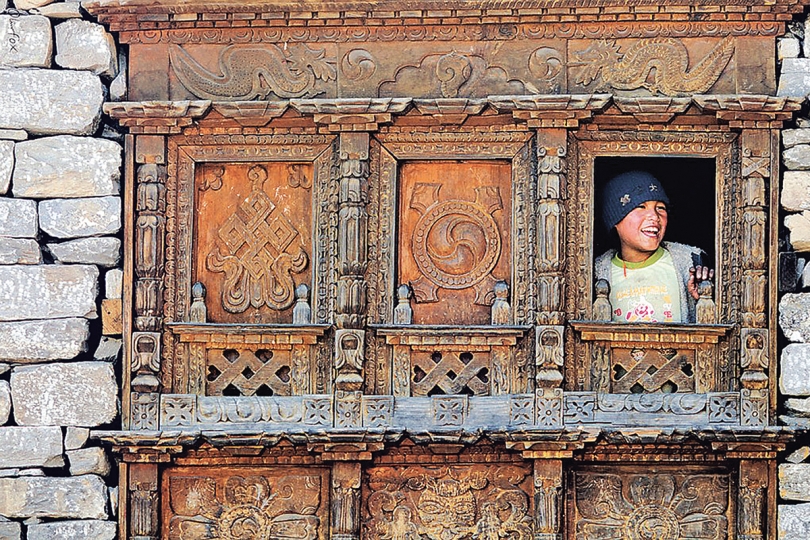In Nepal, life sours under tin ceilings

The village of Gatlang was famous for its wooden roofs blackened with age - then came the earthquakes
Phurba Jyalmu has been telling anyone who’ll listen that the village of Gatlang in Nepal’s Rasuwa district must be rebuilt the way it was. Now that the aftershocks from last year’s earthquakes have finally ended, the 78-year-old wants the community to stay true to its commitment of using zinc-sheet roofs only as a temporary solution.
“If not,” says Jyalmu – looking at the village now peppered with tarps and CGI zinc – “this is the beginning of the end.”
In the immediate aftermath of the 2015 quakes, when various agencies and groups arrived at Gatlang, they were surprised to find the residents firmly against using the silver-coloured CGI sheets they’d brought with them. “Our village was famous for its black roofs,” says Phurba Singhi Tamang, coordinator of the Gatlang Rebuilding Commi-ttee. “It was an important part of our heritage and identity. Initially the rejection of the CGI sheets was unanimous, but with the monsoon and winter approaching, we decided to use them very temporarily. We hope to change that once the housing grants start
filtering in.”
Prior to the quakes, the remote district more than 100 kilometres from Kathmandu was a popular stopover for tourists heading into the Langtang region.
Tsewang Norbu Lama of the non-profit Umbrella Organisation, which strives to alleviate the impacts of poverty and drug-trafficking in the region, says the village was “the gem of the Tamang Heritage Trail”. Gatlang, he says, was lovingly called “the black village” by travellers because of its black wooden roofs and clustered |layout.
Jyalmu asserts that Gatlang’s black roofs have been a part of its heritage for well over 800 years. Constructed with traditional Tamang sensibilities, the roofs were made of large wooden shingles cut in nearby forests that gradually turned black. The houses’ stone walls were framed by wooden pillars intricately engraved with traditional symbols and prayers. Most of the houses, says Jyalmu, had engravings of the Buddha and lotuses or Tibetan mantras for happiness and prosperity.
The prosperity |the village once enjoyed is slowly dissipating, says Pasang Tamang, peering out of her temporary shelter of zinc sheets. “This is a new experience for me. All of us have always lived in traditional houses. It’s been over a year since the earthquakes and we haven’t been able to begin rebuilding.”
Her biggest fear, she says, is that future generations will lose a vital connection to their heritage should the community fail to rebuild as it was. “Besides, why would travellers continue coming here if the one thing that set us apart is lost forever?”
Tourism was a vital source of income for the residents. With the farming output relatively sparse, many locals had successfully transformed their dwellings into cosy home-stays. The Rural Tourism Promotion Centre in Rasuwa noted that Gatland drew 6,000 visitors a year on average.
“From a tourism point of view it’s important that the village maintain its original appearance,” says Tsewang Norbu. “The locals were conscious of this when the CGI sheets started coming in. They knew there would be fewer visitors if they failed to restore its originality. It was the only village on the trail that had the authentic flavour of the Tamang culture, with its traditional architecture and lifestyle.”
Shopkeeper Domo Tamang concurs. “We used to make good money selling produce, handicrafts and groceries to people passing through, but the past year has been rough. Business has all but disappeared and doesn’t look likely to return if we aren’t able to rebuild the village the way it was.”
So far policy provisions, including guidelines on resource mobilisation and grant distribution for the reconstruction of private houses, have not specifically addressed the restoration of houses in traditional ways.
“Although Gatlang’s traditional architecture is somewhat similar to one of the prototype designs proposed by the National Reconstruction Authority, the monetary support the government aims to provide will not be sufficient to construct such houses,” says Manoj Timilsina, a humanitarian worker. The government has budgeted 200,000 rupees (Bt105,000) to rebuild each house destroyed in the quakes, but Phurba Singhi estimates the cost to be closer to a million rupees.
Locals have been lobbying for special consideration with the authority and the District Disaster Relief Committee to help preserve Gatlang’s unique appearance. But, given the widespread havoc wrought on thousands of communities across the country, locals are fully aware that their pleas will likely go unanswered.
That’s why septuagenarian Phurba Jyalmu is telling everyone, with growing urgency, to stand by their original commitment. “I lived my whole life building, expanding and maintaining my black-roofed home,” he says. “I want my grandchildren to be able to understand the value of our traditions. They weren’t just stones stacked together – they were cultural spaces, passed on from one generation to another.
“I don’t want to die under this ugly tin roof.”
RELATED





